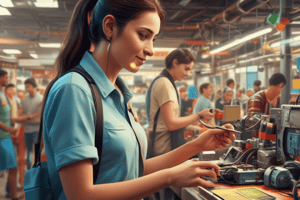Podcast
Questions and Answers
Please briefly define the term "Operations" with a real-life example.
Please briefly define the term "Operations" with a real-life example.
Operations: any process used to transform inputs into some desired outputs. Also known as transformation process. Examples: cooking, breathing.
Please briefly define the term "Systems" with a real-life example.
Please briefly define the term "Systems" with a real-life example.
Systems: a set of interacting or interdependent components forming an integrated whole. Examples: vehicles, airplanes, laptops, assembly lines, production plants.
Please briefly define the term "Products" with a real-life example.
Please briefly define the term "Products" with a real-life example.
Products: Any physical object that can be offered to a market for satisfying a need or want. Examples: mobile phones, TVs, DVD players.
Please briefly define the term "Services" with a real-life example.
Please briefly define the term "Services" with a real-life example.
How many phases of product design are there? Name each of them
How many phases of product design are there? Name each of them
Explain the 1st Phase of product design
Explain the 1st Phase of product design
Explain the 2nd Phase of product design
Explain the 2nd Phase of product design
Explain the 3rd Phase of product design
Explain the 3rd Phase of product design
Explain the 4th Phase of product design
Explain the 4th Phase of product design
Explain the 5th Phase of product design
Explain the 5th Phase of product design
Explain the 6th Phase of product design
Explain the 6th Phase of product design
ABC manufacturing intends to increase its capacity by adding new equipment. Two
vendors have presented proposals. The fixed costs for proposal A are $50,000, and
$70,000 for proposal B. The variable costs for A and B are $12/unit and $10/unit
respectively. The revenue generated by each unit is $20.
What is the break-even point in units for proposal A?
ABC manufacturing intends to increase its capacity by adding new equipment. Two vendors have presented proposals. The fixed costs for proposal A are $50,000, and $70,000 for proposal B. The variable costs for A and B are $12/unit and $10/unit respectively. The revenue generated by each unit is $20.
What is the break-even point in units for proposal A?
ABC manufacturing intends to increase its capacity by adding new equipment. Two
vendors have presented proposals. The fixed costs for proposal A are $50,000, and
$70,000 for proposal B. The variable costs for A and B are $12/unit and $10/unit
respectively. The revenue generated by each unit is $20.
What is the break-even point in units for proposal B?
ABC manufacturing intends to increase its capacity by adding new equipment. Two vendors have presented proposals. The fixed costs for proposal A are $50,000, and $70,000 for proposal B. The variable costs for A and B are $12/unit and $10/unit respectively. The revenue generated by each unit is $20.
What is the break-even point in units for proposal B?
ABC manufacturing intends to increase its capacity by adding new equipment. Two
vendors have presented proposals. The fixed costs for proposal A are $50,000, and
$70,000 for proposal B. The variable costs for A and B are $12/unit and $10/unit
respectively. The revenue generated by each unit is $20.
At what volume (units) of output would the two proposals yield the same profit?
Let QAB be the volume that two proposals would yield the same profit,
ABC manufacturing intends to increase its capacity by adding new equipment. Two vendors have presented proposals. The fixed costs for proposal A are $50,000, and $70,000 for proposal B. The variable costs for A and B are $12/unit and $10/unit respectively. The revenue generated by each unit is $20.
At what volume (units) of output would the two proposals yield the same profit? Let QAB be the volume that two proposals would yield the same profit,
ABC firm is currently making an item with a variable cost of $0.5/unit, and a selling price
of $1.00/unit. Fixed costs are $14,000. Current volume is 30,000 units. The firm can
substantially improve the product quality by adding a new equipment at an additional
fixed cost of $6,000. Variable cost would increase to $0.6/unit, but volume should jump
to 50,000 units due to a higher-quality product. Should ABC buy the new equipment?
ABC firm is currently making an item with a variable cost of $0.5/unit, and a selling price of $1.00/unit. Fixed costs are $14,000. Current volume is 30,000 units. The firm can substantially improve the product quality by adding a new equipment at an additional fixed cost of $6,000. Variable cost would increase to $0.6/unit, but volume should jump to 50,000 units due to a higher-quality product. Should ABC buy the new equipment?
Suppose that you want to determine the volume of sales dollars for the coming year to
reach the break-even point. You are selling four items: beer, meals, desserts with wine,
and lunches with sandwiches as shown in the following table. Your fixed cost is
$1,800/month plus $2,000/month for entertainment.
a. What is your break-even point in dollars per month?
Suppose that you want to determine the volume of sales dollars for the coming year to reach the break-even point. You are selling four items: beer, meals, desserts with wine, and lunches with sandwiches as shown in the following table. Your fixed cost is $1,800/month plus $2,000/month for entertainment.
a. What is your break-even point in dollars per month?
What is the expected number of meals each day if you are open 30 days a
month?
What is the expected number of meals each day if you are open 30 days a month?
Flashcards
Capital of France (example flashcard)
Capital of France (example flashcard)
Paris


